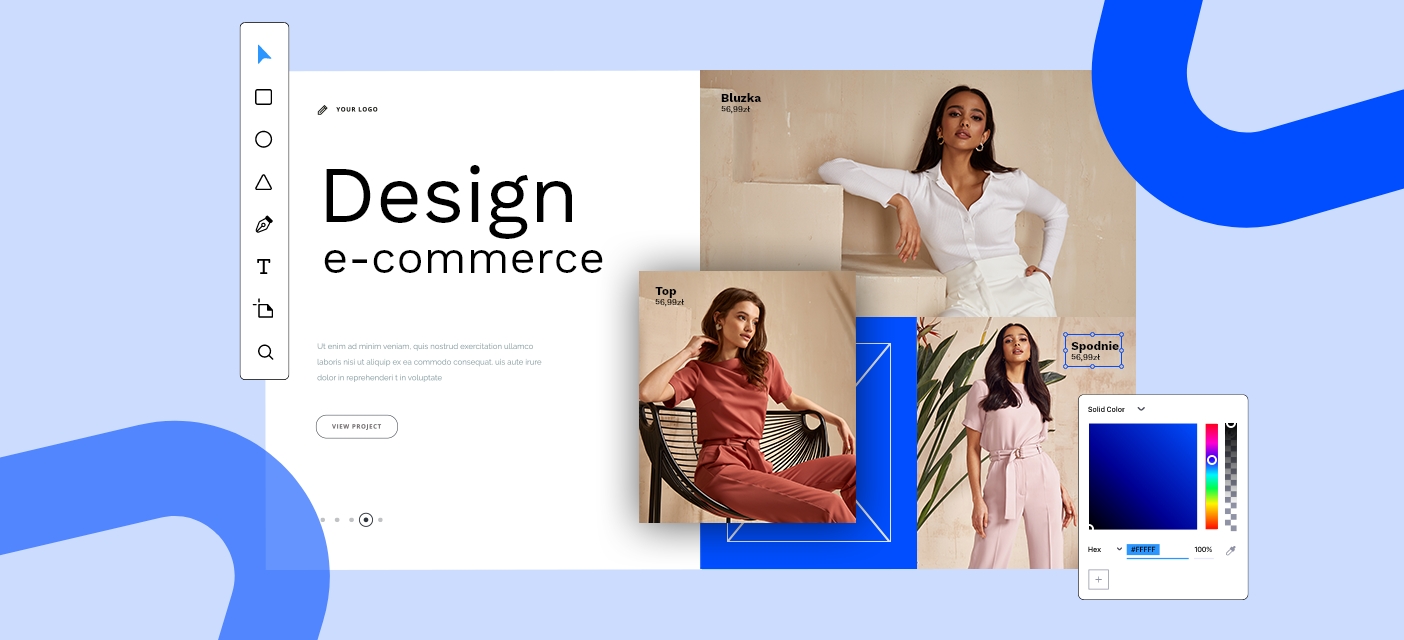

In today’s dynamic world of e-commerce, standing out from the competition is becoming a key challenge. Design is one of the most powerful tools in building a unique character for an online store. It is much more than just aesthetics—it is a strategic element that shapes first impressions, builds customer trust, and loyalty.
Before we delve into specific visual elements, it is worth considering why design plays such a fundamental role in e-commerce.
Professional design directly translates into Customer Lifetime Value (CLV)
The appearance of a website has a decisive impact on how users perceive the online store. A visually attractive e-shop is more likely to interest and retain visitors, arousing curiosity and encouraging them to browse the offer further, which is crucial in building a positive first contact. From a business perspective, a positive first impression directly translates into a lower bounce rate and a longer time spent by users on the website, which in turn increases the chances of conversion and sales. It is therefore worth investing in professional design to attract and engage potential customers from the very beginning of their interaction.
An original visual identity, consistently implemented across all platforms, makes the business recognizable and memorable. Unique design builds brand awareness. Users more easily remember and recognize stores that stand out visually, which in the long run translates into a competitive advantage, customer loyalty, and the possibility of charging higher margins due to a stronger position in their consciousness.
A website designed with attention to detail and visual consistency communicates professionalism and reliability of the business. Customers subconsciously attribute greater credibility to aesthetic appearance. A consistent identity, visible in every design element, builds a strong foundation of trust, which is essential to convince users to make a purchase. Trust is key in e-commerce, where interaction with the product is limited to the virtual sphere. Professional design minimizes customer concerns regarding transaction security and the quality of offered products. It is important to maintain a credible presentation that builds confidence and directly influences the increase in conversions and the reduction of abandoned carts.
When a store’s design is consistent and memorable, customers more easily identify the products and services offered. Customers return to stores they know and that evoke positive visual associations. From a business point of view, loyal customers generate repeat purchases and are less price-sensitive. Strong recognition, supported by consistent design, makes it easier for customers to return and recommend the store to others. This translates into lower customer acquisition costs and a higher Customer Lifetime Value (CLV).
4 key elements for building a consistent visual identity for an online store
It is worth examining the key visual aspects that collectively create and define the unique identity of a store. The key elements for creating a visual identity include:
- Logo design: The logo, as a business card, should be simple, easily memorable, and reflect the business values, becoming an iconic symbol. From a business perspective, a strong logo increases recognition and builds a professional image, being a key element of visual identification that appears at all customer contact points.
- Color palette : A conscious selection of a color palette, consistent with the nature of the offer, helps in building a specific image, having a powerful impact on emotions and perception. Appropriately chosen colors strengthen the message and evoke desired emotions in customers, and their consistent use builds recognition and helps differentiate from the competition.
- Typography: The choice of appropriate fonts is crucial for the readability and reception of the message. The deliberate use of specific fonts in all branding materials strengthens the visual identity. Clear and aesthetic typography, from a business point of view, improves the user comfort of the website and facilitates the assimilation of information.
- Video and product photography: Presenting high-quality photos and video materials allows customers to better understand the offered products. Professional product and lifestyle photos increase the attractiveness of the offer and help customers imagine their use. Visually attractive product presentations increase interest in the offer and encourage purchase, while high-quality photos build trust and reduce the risk of returns.
Read more: 10 common web design mistakes that can cost you
Consistent design increases customer loyalty
The key to a strong identity is visual consistency at every stage of customer contact. This includes not only the website but also social media, advertising materials, email marketing, product packaging, and even customer service communication. A uniform appearance and communication style strengthen recognition and build a consistent customer experience, increasing their trust and building loyalty.
Design and User Experience (UX)
Design is not limited only to the visual layer—it has a huge impact on website usability (UX). Intuitive navigation, responsiveness (adaptation to different devices), and an attractive interface translate into positive user experiences. Personalization, supported by design, further increases customer engagement and loyalty, making them feel more connected to the store. Good UX from a business perspective increases customer satisfaction, leading to higher conversion rates, lower bounce rates, and greater loyalty. An intuitive website makes it easier for customers to search for and purchase products, which directly translates into sales growth. In turn, personalization strengthens the relationship with the customer and increases the likelihood of their return.
Design is a strategic investment in the long-term success of e-commerce business
Design in e-commerce is the foundation for building a store’s unique character. Conscious and consistent use of visual elements, combined with attention to UX and personalization, not only allows a business to stand out in a competitive market but, above all, to build lasting customer relationships based on trust and loyalty. It is worth remembering that investing in thoughtful design is an investment in the long-term success of an e-commerce business.


